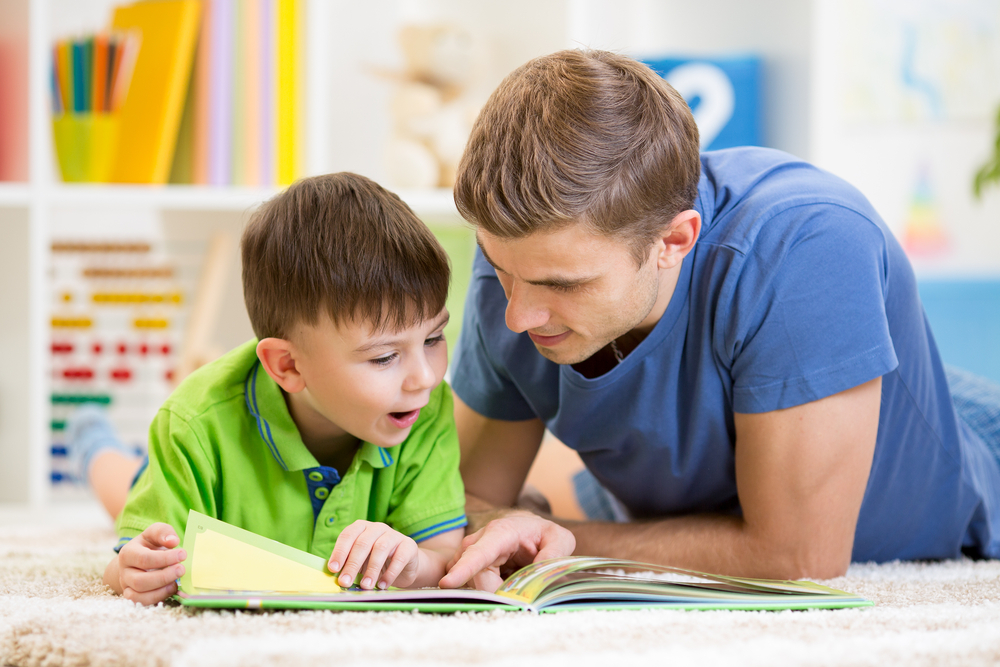Research shows that reading with children from a young age greatly impacts their long-term vocabulary development (Mol & Bus, 2011). It is also a great time to bond with your child no matter what age!
Vocabulary means knowing the meaning of words. Reading storybooks with children helps them to develop a larger inventory of words and helps them develop the knowledge required for eventual success in emergent literacy and reading achievement (Hill, 2012).

In order to build a more extensive vocabulary, it is important to find the right reading material. It is important to find books that your child will be interested in and are appropriate for your child’s age.
To source books without spending too much or any money, try:
- Borrowing books from the library
- Looking out for library sales, second hand shops and garage sales
- Giving books as presents and encouraging family and friends to do the same
- Swapping books with friends and family
- Making your own books using photos of your child or cut out pictures from magazines, newspapers, or pictures from the internet

There are 6 important steps a parent can follow to encourage their child to build more extensive vocabulary.
Step 1: Read the book before you read it to your child and choose 2-4 more complex words to teach
When choosing complex words you could choose words that:
Replace everyday familial words with less commonly used words (e.g. “sprint” instead of “run” or “drowsy” instead of “tired”)
Introduce words that represent new concepts that your child may not know yet (e.g. “carnivore”, “surgeon” etc.)
Target a range of new word types such as verbs or action words (e.g. “snorkel”), emotions (e.g. “irritated”, “delighted” etc.), and adjectives or describing words (e.g. “massive”, “shimmering”)
Step 2: When reading the book to your child, highlight and emphasise the word and demonstrate the meaning of the word
Use facial expressions (e.g. to dramatise being “drowsy”)
Use gestures or act out the gesture when possible (e.g. use your hands to demonstrate “massive”)
Change the way you say the word (e.g. speak in at a high pitch when you say “delighted”)
Point out the pictures in the book that explain the word (e.g. point to the picture of the boy who is running fast to explain “sprint”)
Step 3: Provide a definition or explain the meaning of the word to the child
Provided a definition of the word (e.g. “He is feeling exhausted. Exhausted means when someone is really really tired”).
Provide a word that is opposite in meaning (e.g. “The opposite of feeling exhausted is being wide awake and exhausted”).
Provide your child with an example sentence using the word (e.g. “The man was so exhausted after his long walk”).
Step 4: Relate the word to your child’s experience
Provide an example of when your child could relate to the word. (e.g. If you were explaining the word “crawling”, you might say “Do you remember when we saw your baby cousin? He was crawling on the ground”)
Step 5: Encourage your child to use the word in a sentence
Encourage your child to build a sentence using the word that you have just taught them using the book in front of you or in conversation with them.
You can even ask them a question related to the pictures in the book and provide a model of the word in the sentence again (e.g. “How do you think the dog is feeling? Yes, he’s feeling afraid. The dog is feeling afraid”)
Step 6: Repeat, repeat, repeat!
It is important that your child needs to listen to the same words many times before they are able to use the word in conversation or when answering a question.
Repeat the word as many times during the shared book reading time.
You may want to re-read the book several times in the week so that your child familiarise themselves with the new vocabulary.

References
Hill, S. (2012). Developing early literacy: assessment and teaching (2nd ed.). South Yarra, Vic. Eleanor Curtain Publishing.
Mol, S.E. and A.G. Bus (2011). To Read or Not to Read: A Meta-Analysis of Print Exposure From Infancy to Early Adulthood, Psychological Bulletin, 137, 267–296.
